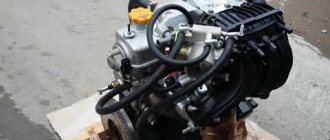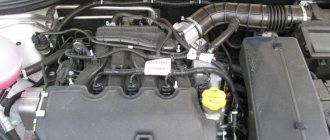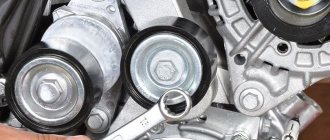Description
The VAZ-11189 engine was created in 2016. It was first positioned at the Moscow Motor Show in the Lada Largus car. The production was mastered by the VAZ automobile plant in Togliatti.
The internal combustion engine in question is an improved copy of the successful VAZ-11186. Looking ahead somewhat, I would like to note that the new version of the engine turned out to be improved and modified in comparison with the previous model.
VAZ-11189 is a four-cylinder naturally aspirated petrol engine with a volume of 1.6 liters and a power of 87 hp. s and a torque of 140 Nm.
Since its release, the engine has been installed on Largus with van and station wagon bodies. Later found application on other Lada models (Priora, Granta, Vesta.).
The VAZ-11189 is characterized by high traction at the “bottom” and “agility” at high speeds, similar to 16-valve internal combustion engines. Car owners are pleased with the efficiency of the engine.
For example, fuel consumption on a Lada Largus (station wagon, manual transmission) on the highway is 5.3 l/100 km. In addition, another pleasant moment is the manufacturer’s official permission to use AI-92 gasoline for the engine. But, we must pay tribute that it is impossible to fully reveal the technical and operational capabilities of the engine with this fuel.
The VAZ-11189 developed for the Lada Largus had differences from its predecessor in attachments. Thus, the generator, power steering pump and air conditioning compressor were replaced with more reliable and modern ones, and the CPG was redesigned.
The engine received a more efficient catalyst built into the exhaust manifold. A special feature of the internal combustion engine is the location of the pump, which is rotated by the timing belt.
New technologies were used in the manufacture of the engine. For example, the connecting rod head is produced by the tearing method. This completely eliminates the appearance of gaps at the junction of the cover and the connecting rod body.
The channels in the cooling system of the cylinder block and its head have been changed. As a result, the heat removal process has become more intense.
Anti-friction graphite coating is applied to the piston skirts, which eliminates scuffing in the cylinder and piston when starting a cold engine.
The intake system has received significant changes. A new noise absorber resonator and a new generation throttle pipe were installed.
It was possible to increase the efficiency of the engine through the use of a lightweight piston group from Federal Mogul, the use of many imported parts and components, and the introduction of innovative technologies (electronic throttle valve control - PPT E-Gas).
A set of engineering solutions ensured good performance and reduced noise and vibration levels.
Performance Comparison
The graph above clearly shows that the VAZ-11189 is almost as good as the 16-valve VAZ-21129 in power and torque. Against the background of low fuel consumption, these figures are more than satisfactory.
The VAZ-11189 turned out to be quite acceptable for use. Most car owners recognized it as a quite successful unit.
Replacing the head cover gasket on a 16 valve Lada Largus engine
You will need: the tools necessary to remove the air filter and ignition coils, as well as a 10-mm socket, a flat-blade screwdriver, a knife, a mounting spudger, and a torque wrench.
To restore the cylinder head cover seal of the K4M engine, do the following.
1. Disconnect the wire from the negative terminal of the battery. 2. Remove the air filter. 3. Remove the intake pipe receiver (see “Replacing the intake pipe seals”). 4. Remove the oil separator (see “Cleaning the crankcase ventilation system”). 5. Remove the right support for the power unit suspension (see “Replacing the right support for the Lada Largus power unit suspension”).6. Remove the upper timing belt cover (see “Installing the piston of the first cylinder to the TDC position of the compression stroke”). 7. Remove the twenty-four bolts securing the cylinder head cover (Fig. 1)… 8. …pry the cylinder head cover with a mounting blade…
9. ...and take it off.
10. Clean the mating surfaces of the cover and cylinder head from old sealant. 11. Apply oil-resistant gasket sealant to the mating surface of the cylinder head.
This is what the gasket sealant looks like applied to the mating surface of the cylinder head (for clarity, shown on the cylinder head with the camshafts removed). 12. Install the cover on the cylinder head. 13. Tighten the cylinder head cover bolts in three stages: Stage I - tighten the bolts in the sequence shown in Fig. 1. Tighten bolts 1-12, 14-19, 21 and 24 to a torque of 12Nm, bolts 13, 20, 22, 23 to a torque of 8Nm; Stage II - loosen bolts 22, 23, 20, 13; Stage III - tighten bolts 22,23,20,13 to a torque of 12 N*m. 14. Install the remaining parts in the reverse order of removal.
Rice. 1. The procedure for tightening the bolts securing the head cover of the Lada Largus cylinder block.
In 2011, in Russia, Renault and VAZ began assembling the Dacia Logan MCV, adapted for the local market. The Russian version was called Lada Largus. Magnitogorsk did not stand aside. Largus Park is growing rapidly.
VAZ offers a five-seat passenger station wagon, a seven-seat high-capacity station wagon with three rows of seats, and a cargo van. Each version of the Lada Largus is equipped with either an eight-valve 1.6i engine (K4M) with a power of 84 l/s or a sixteen-valve engine 1.6i 16V (K7M) with a power of 105 l/s. Most of the engine parts, steering, and suspension are the same as on the Logan.
Lada Largus configurations: FS015 - Van 1.6i (K4M), FS0Y5 - Van 1.6i 16V (K7M), KS015 - station wagon 5 seats 1.6i (K4M), KS0Y5 - station wagon 5 seats 1.6i 16V (K7M), RS015 - 7 seats 1.6i (K4M), RS0Y5 - 7 seats 1.6i 16V (K7M)
The catalog number is indicated in the original column. In the column with a non-original replacement and the name of the manufacturer, the original part is indicated if the price for it is not too high.
Specifications
| Manufacturer | Autoconcern "AvtoVAZ" |
| Start year of release | 2016 |
| Volume, cm³ | 1596 |
| Power, l. With | 87 |
| Torque, Nm | 140 |
| Compression ratio | 10.5 |
| Cylinder block | cast iron |
| Number of cylinders | 4 |
| cylinder head | aluminum |
| Fuel injection order | 1-3-4-2 |
| Cylinder diameter, mm | 82 |
| Piston stroke, mm | 75.6 |
| Number of valves per cylinder | 2 (SOHC) |
| Timing drive | belt |
| Turbocharging | No |
| Hydraulic compensators | No |
| Valve timing regulator | No |
| Lubrication system capacity, l | 3.5 |
| Oil used | 5W-30, 5W-40, 10W-40 |
| Oil consumption (calculated), l/1000 km | n/a |
| Fuel supply system | injector, distributed injection |
| Fuel | gasoline AI-95* |
| Environmental standards | Euro 5** |
| Resource, thousand km | 200 |
| Location | transverse |
| Weight, kg | 112 |
| Tuning (potential), l. With | 130*** |
*the use of AI-92 gasoline is officially allowed; ** for Europe the standard has been increased to Euro 6; ***increasing power without reducing service life – up to 100 hp. With
When valve adjustment is required
Engine valves increase in size when exposed to high temperatures. For this reason, adjustment can only be carried out correctly on a cold engine. A schematic diagram of the valve mechanism is shown in the figure.
Lada Largus engine valve mechanism diagram
Where:
- Clearance adjustment nut.
- Lock-nut.
- Plate.
- Crackers.
- Spring.
- Oil scraper cap.
- Camshaft cam.
- Rocker.
- A – Thermal gap.
According to the manufacturer's regulations, thermal clearances must strictly comply with the following values:
- for exhaust valves – 0.25-0.30 mm;
- for intake valves – 0.01-0.15 mm.
It is recommended to perform the adjustment every 100 thousand kilometers, as well as when extraneous metallic sounds appear in the head and the camshaft clicking at idle.
Reliability, weaknesses, maintainability
Reliability
The VAZ-11189 engine is considered a reliable power unit. This is confirmed by numerous reviews on various forums. For example, Alexey from Barnaul writes: “...I bought a Largus with 8 valve 11189. The engine is as simple as an axe. There are no problems with him. Accelerates and drives as it should. I change the oil every 9 thousand km. There is no expense. Lew shell 5 x 40 ultra...” Dmitry from Ufa states: “...There are 2 Largus in our company. One with a 16-valve engine, the other with an 8-valve engine. Shesnar eats a little butter, 11189 does not eat at all. In terms of escape, they are almost identical - 100 and 120 thousand km, respectively. Conclusion - take the 8-valve Largus...”
The general trend of reviews is that car owners are satisfied with the engine, the engine does not cause problems.
The reliability of the VAZ-11189 is clearly indicated by the fact that it exceeds the resource declared by the manufacturer. With timely maintenance, the engine is able to operate up to 400-450 thousand km without major repairs. (Such figures are confirmed by “hardened” taxi drivers).
And one more thing. The AvtoVAZ automobile concern abandoned imported Renault K4M and K7M engines in favor of the VAZ-11189. The conclusion is simple - if 11189 were not reliable, the Lada Largus would have French engines.
Weak spots
Despite the high reliability, the VAZ-11189 has several weaknesses. The most significant are the following.
Low quality mass air flow sensor. It is his fault that the engine sometimes stalls while driving.
An unreliable thermostat leads to engine overheating.
Water pump. Cases of jamming are not uncommon. In this case, a break in the timing belt is inevitable.
Floating idle speed. They mainly occur when various sensors fail. First of all, in the throttle valve control system (E-Gas).
Engine tripping. The cause of the malfunction lies in problems with the ignition system or burnt-out valves.
Unauthorized knocks in the engine compartment. In most cases, they are caused by out-of-adjustment valves. Timely adjustment of thermal clearances eliminates the appearance of this weak point of the internal combustion engine.
If any problem occurs, engine diagnostics at a specialized service station is mandatory.
A broken timing belt causes the valves to bend. Despite the long service life of the belt (180-200 thousand km), it will have to be replaced after 40-50 thousand km due to unreliable bearing units of the pump and tension roller.
Other faults are not critical and occur rarely.
Sixteen-valve K4M
- fuel consumption in mixed mode is about 9 liters per 100 kilometers;
- quiet operation;
- no vibration.
If you are thinking which unit is better for Largus, then you should carefully consider the option with sixteen valves. It is more complex, so the cost of a car equipped with such an engine will be slightly higher. Servicing a sixteen-valve engine will also cost you a lot of money, but at the same time you can easily drive over 450 thousand kilometers on it
It is only important to take care of it, listen to the advice of experts at the service station, change components on time and not put too much load on it.
- skipping speed when using low quality fuel;
- insufficient dynamics;
- expensive spare parts;
- high prices for service in service centers.
If we compare the two engines, then, undoubtedly, the K4M is more profitable, since it does not require frequent valve adjustments. Its disadvantages are not as significant as those of the eight-valve K7M.
What's the result?
As you can see, the engines on the Lada Largus are classic 8- and 16-valve gasoline units, adapted to Euro 4 and Euro 5. Even taking into account a number of features, these engines turned out to be quite reliable. However, in practice, VAZ engines are somewhat inferior to Renault-Nissan internal combustion engines. At the same time, servicing and repairing domestic units is still cheaper than imported power plants.
We also recommend reading the article about what engine is in the Lada Granta. From this article you will learn about the features, characteristics, as well as the advantages and disadvantages of the Lada Granta engine. One way or another, taking into account the characteristics discussed above, every potential owner of a Lada Largus (especially if a used car is selected) can decide exactly what type engine, it is better to purchase this model.
In turn, this will make it possible to meet expectations after the purchase, since it is important to take into account in advance the features of a particular car, the life of its internal combustion engine, the cost of maintenance and repairs, etc.
Sources used:
- https://xn--80aal0a.xn--80asehdb/reviews-tests/lada-largus-reviews-tests/292-kakoy-dvigatel-na-lada-largus.html
- https://largus-shop.spb.ru/helpful/item/5045-dvigateli-lada-largus
- https://krutimotor.ru/dvigateli-lada-largus-vidy-i-harakteristiki/
New VAZ 11182 engine
At the beginning of 2022, AVTOVAZ introduced a new 8-valve 1.6-liter engine (VAZ 11182 or AR16SEg2), which first appeared on the Lada Largus FL and will later appear on the Lada Granta FL.
AVTOVAZ writes that the new engine featured an updated connecting rod and piston group, a modernized crankshaft and a gas distribution mechanism. As a result, power is increased to 90 hp, and 80% of torque is available from 1000 rpm, which reduces fuel consumption and reduces shift frequency. In addition, the need to adjust valves before a mileage of 90,000 kilometers is eliminated. The engine is adapted to run on gasoline with an octane rating of 92. Read more about the design in this review. Technical characteristics and reviews about it are at the link.
Let us remind you that you can read about the VAZ 21129 engine here.
Key words: Lada Largus engine
Share on social networks:
Found an error? Select it and press Ctrl+Enter..











